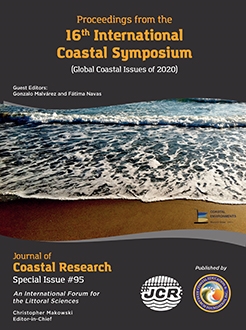Bouvier, C.; Balouin Y.; Castelle B., and Valentini N., 2020. Video depth inversion at a microtidal site exposed to prevailing low-energy short-period waves and episodic severe storms. In: Malvárez, G. and Navas, F. (eds.), Global Coastal Issues of 2020. Journal of Coastal Research, Special Issue No. 95, pp. 1021–1026. Coconut Creek (Florida), ISSN 0749-0208.
Over the last decades, a wide range of depth inversion algorithms have been developed, which aim to infer local water depth from remotely-sensed wave parameters based on physical relations. Particularly, the depth inversion algorithm named cBathy (Holman, Plant, and Holland, 2013) showed good results for a range of wave conditions and environments but the method was only applied to beaches exposed to moderate or highly energetic wave climate, with wave peak period often larger than 8 s. This paper applies the cBathy algorithm for the very first time on a Mediterranean Sea beach, Sète, southeast France, a semidiurnal microtidal environment exposed to a moderate-energy modal wave climate and episodic severe storms. The objective of the paper is to assess the ability of the cBathy algorithm to estimate the nearshore bathymetry for waves with large energy spread in both direction and frequency. After a comparison between the remotely sensed bathymetry and a ground truth bathymetric survey, we use a non-linear, depth-averaged morphodynamic model, 2DBeach (Dubarbier et al., 2017), on remotely sensed bathymetries to determine the sensitivity of nearshore waves and horizontal circulations to the estimated morphology. The depth inversion technique estimates the nearshore bathymetry with good accuracy (RMSE = 0.39 m) for a beach area extending respectively 1600 m and 600 m in the longshore and cross-shore directions, respectively, suggesting the technical feasibility of coupling remotely-sensed bathymetry to 2DH numerical model, even at short-waves exposed Mediterranean beaches.





